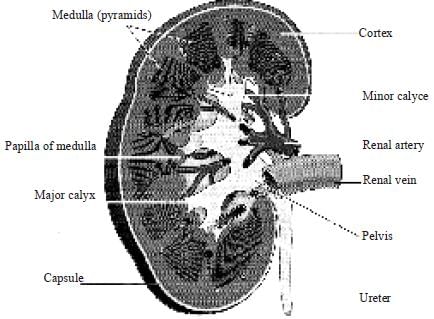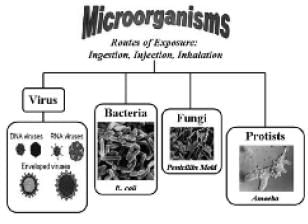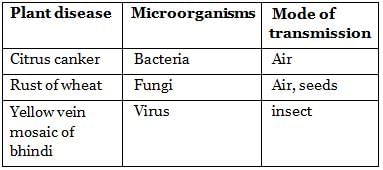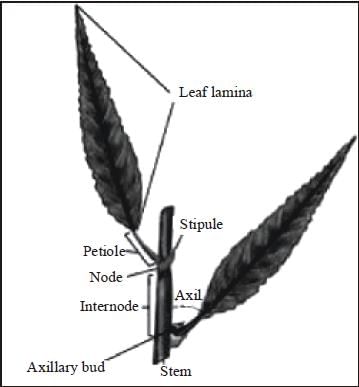NCERT Summary: Summary of Biology- 7 | Science & Technology for UPSC CSE PDF Download
THE EXCRETORY SYSTEM
Excretory Systems in Various Animals
Excretory systems regulate the chemical composition of body fluids by removing metabolic wastes and retaining the proper amounts of water, salts, and nutrients. Components of this system in vertebrates include the kidneys, liver, lungs, and skin.
Not all animals use the same routes or excrete their wastes the same way as humans do. Excretion applies to metabolic waste products that cross a plasma membrane. Elimination is the removal of feces.
A. Nitrogen Wastes
Nitrogen wastes are by product of protein metabolism. Amino groups are removed from amino acids prior to energy conversion. The NH2 (amino group) combines with a hydrogen ion (proton) to form ammonia (NH3).
Ammonia is very toxic and usually is excreted directly by marine animals. Terrestrial animals usually need to conserve water. Ammonia is converted to urea, a compound the body can tolerate at higher concentrations than ammonia. Birds and insects secrete uric acid that they make through large energy expenditure but little water loss.
Amphibians and mammals secrete urea that they form in their liver. Amino groups are turned into ammonia, which in turn is converted to urea, dumped into the blood and concentrated by the kidneys.
(B) Water and Salt Balance
The excretory system is responsible for regulating water balance in various body fluids. Osmoregulation refers to the state aquatic animals are in: they are surrounded by freshwater and must constantly deal with the influx of water. Animals, such as crabs, have an internal salt concentration very similar to that of the surrounding ocean. Such animals are known as osmocon-formers, as there is little water transport between the inside of the animal and the isotonic outside environment. Marincompositione vertebrates, however, have internal concentrations of salt that are about one-third of the surrounding seawater. They are said to be osmoregulators. Osmoregu-lators face two problems: prevention of water loss from the body and prevention of salts diffusing into the body. Fish deal with this by passing water out of their tissues through their gills by osmosis and salt through their gills by active transport.
Cartilaginous fish have a greater salt concentration than seawater, causing water to move into the shark by osmosis; this water is used for excretion. Freshwater fish must prevent water gain and salt loss. They do not drink water, and have their skin covered by a thin mucus. Water enters and leaves through the gills and the fish excretory system produces large amounts of dilute urine. Terrestrial animals use a variety of methods to reduce water loss: living in moist environments, developing impermeable body coverings, production of more concentrated urine.
Water loss can be considerable: a person in a 100 degree F temperature loses 1 liter of water per hour.
Excretory System Functions
1. Collect water and filter body fluids.
2. Remove and concentrate waste products from body fluids and return other substances to body fluids as necessary for homeostasis.
3. Eliminate excretory products from the body.
Invertebrate Excretory Organs
Many invertebrates such as flatworms use a nephridium as their excretory organ. At the end of each blind tubule of the nephridium is a ciliated flame cell. As fluid passes down the tubule, solutes are reabsorbed and returned to the body fluids.
Body fluids are drawn into the Malphigian tubules by osmosis due to large concentrations of potassium inside the tubule. Body fluids pass back into the body, nitrogenous wastes empty into the insect’s gut. Water is reabsorbed and waste is expelled from the insect.
The Human Excretory System
The urinary system is made-up of the kidneys, ureters, bladder, and urethra. The nephron, an evolutionary modification of the nephridium, is the kidney’s functional unit. Waste is filtered from the blood and collected as urine in each kidney. Urine leaves the kidneys by ureters, and collects in the bladder. The bladder can distend to store urine that eventually leaves through the urethra.
(a) The Nephron
The nephron consists of a cup-shaped capsule containing capillaries and the glomerulus, and a long renal tube. Blood flows into the kidney through the renal artery, which branches into capillaries associated with the glomerulus. Arterial pressure causes water and solutes from the blood to filter into the capsule. Fluid flows through the proximal tubule, which include the loop of Henle, and then into the distal tubule. The distal tubule empties into a collecting duct. Fluids and solutes are returned to the capillaries that surround the nephron tubule.
The nephron has three functions:
1. Glomerular filtration of water and solutes from the blood.
2. Tubular reabsorption of water and conserved molecules back into the blood.
3. Tubular secretion of ions and other waste products from surrounding capillaries into the distal tubule.
Nephrons filter 125 ml of body fluid per minute; filtering the entire body fluid component 16 times each day. In a 24 hour period nephrons produce 180 liters of filtrate, of which 178.5 liters are reabsorbed. The remaining 1.5 liters forms urine.
(B) Urine Production
1. Filtration in the glomerulus and nephron capsule.
2. Reabsorption in the proximal tubule.
3. Tubular secretion in the Loop of Henle.

(C) Cmponents of the NEPHRON
- Glomerulus: mechanically filters blood
- Bowman’s Capsule: mechanically filters blood
- Proximal Convoluted Tubule: Reabsorbs 75% of the water, salts, glucose, and amino acids
- Loop of Henle: Countercurrent exchange, which maintains the concentration gradient
- Distal Convoluted Tubule: Tubular secretion of H ions, potassium, and certain drugs.
(D) Kidney Stones
In some cases, excess wastes crystallize as kidney stones. They grow and can become a painful irritant that may require surgery or ultrasound treatments. Some stones are small enough to be forced into the urethra, others are the size of huge, massive boulders.
(E) Kidney Functions
Kidneys perform a number of homeostatic functions:
1. Maintain volume of extracellular fluid
2. Maintain ionic balance in extracellular fluid
3. Maintain pH and osmotic concentration of the extracellular fluid.
4. Excrete toxic metabolic by-products such as urea, ammonia, and uric acid.
Hormone Control of Water and Salt
Water reabsorption is controlled by the antidiuretic hormone (ADH) in negative feedback.
ADH is released from the pituitary gland in the brain. Dropping levels of fluid in the blood signal the hypothalamus to cause the pituitary to release ADH into the blood. ADH acts to increase water absorption in the kidneys. This puts more water back in the blood, increasing the concentration of the urine. When too much fluid is present in the blood, sensors in the heart signal the hypothalamus to cause a reduction of the amounts of ADH in the blood. This increases the amount of water absorbed by the kidneys, producing large quantities of a more dilute urine. Aldosterone, a hormone secreted by the kidneys, regulates the transfer of sodium from the nephron to the blood. When sodium levels in the blood fall, aldosterone is released into the blood, causing more sodium to pass from the nephron to the blood. This causes water to flow into the blood by osmosis. Renin is released into the blood to control aldosterone.
PHOTOSYNTHESIS
Structure of leaf
- Plants are the only photosynthetic organisms to have leaves (and not all plants have leaves). A leaf may be viewed as a solar collector crammed full of photosynthetic cells.
- The raw materials of photosynthesis, water and carbon dioxide, enter the cells of the leaf, and the products of photosynthesis, sugar and oxygen, leave the leaf.

- Water enters the root and is transported up to the leaves through specialized plant cells known as xylem.
- Land plants must guard against drying out (desiccation) and so have evolved specialized structures known as stomata to allow gas to enter and leave the leaf. Carbon dioxide cannot pass through the protective waxy layer covering the leaf (cuticle), but it can enter the leaf through an opening (the stoma; plural = stomata; Greek for hole) flanked by two guard cells.
- Likewise, oxygen produced during photosynthesis can only pass out of the leaf through the opened stomata.
- Unfortunately for the plant, while these gases are moving between the inside and outside of the leaf, a great deal water is also lost.
- Cottonwood trees, for example, will lose 100 gallons of water per hour during hot desert days. Carbon dioxide enters single-celled and aquatic autotrophs through no specialized structures.
Chlorophyll and Accessory Pigments
- A pigment is any substance that absorbs light. The color of the pigment comes from the wavelengths of light reflected (in other words, those not absorbed).
- Chlorophyll, the green pigment common to all photosynthetic cells, absorbs all wavelengths of visible light except green, which it reflects to be detected by our eyes.
- Black pigments absorb all of the wavelengths that strike them.
- White pigments/lighter colors reflect all or almost all of the energy striking them. Pigments have their own characteristic absorption spectra, the absorption pattern of a given pigment.
- Chlorophyll is a complex molecule. Several modifications of chlorophyll occur among plants and other photosynthetic organisms. All photosynthetic organisms (plants, certain protistans, prochlorobacteria, and cyanobacteria) have chlorophyll a. Accessory pigments absorb energy that chlorophyll a does not absorb. Accessory pigments include chlorophyll b (also c, d, and e in algae and protistans), xanthophylls, and carotenoids (such as beta-carotene). Chlorophyll absorbs its energy from the Violet-Blue and Reddish orange-Red wavelengths, and little from the intermediate (Green-Yellow-Orange) wavelengths.
The Carbon Cycle
- Plants may be viewed as carbon sinks, removing carbon dioxide from the atmosphere and oceans by fixing it into organic chemicals. Plants also produce some carbon dioxide by their respiration, but this is quickly used by photosynthesis. Plants also convert energy from light into chemical energy of C-C covalent bonds. Animals are carbon dioxide producers that derive their energy from carbohydrates and other chemicals produced by plants by the process of photosynthesis.
- The balance between the plant carbon dioxide removal and animal carbon dioxide generation is equalized also by the formation of carbonates in the oceans. This removes excess carbon dioxide from the air and water (both of which are in equilibrium with regard to carbon dioxide). Fossil fuels, such as petroleum and coal, as well as more recent fuels such as peat and wood generate carbon dioxide when burned. Fossil fuels are formed ultimately by organic processes, and represent also a tremendous carbon sink. Human activity has greatly increased the concentration of carbon dioxide in air.
DIVERSITY IN LIVING ORGANISMS
Differentiation in Plants
(i) Thallophyta
- Plants that do not have well differentiated body design fall in this group.
- The plants in this group are commonly called algae. These plants are predominantly aquatic.
Example: Spirogyra, cladophora and chara.
(ii) Bryophyte
- These are called the amphibians of the plant kingdom. There is no specialized tissue for the conduction of water and other substances from one past of the plant body to another.
Example: moss (fumaria) and marchantia
(iii) Pteridopheysta
- In this group plant body is differentiated into roots, stem and leaves and has specialized tissue for the conduction of water and other substances from one plant of the plant body to another.
Example: marsilea, ferns, and horse tails.
(iv) Gymnosperms
- The plant of this group bear naked seeds and one usually perennial and evergreen and woody.
Example: pines such as deodar.
(v) Angiosperms
- The seeds develop inside an organ which is modified to become a fruit. These are also called flowering plants.
- Plant embryos in seeds have structures called cotyledons. Cotyledons are called seed leaves because in many instances they emerge and become green the seed germinates.
- The angiosperms are divided into two groups on the basis of the number of cotyledons present in the seed.
- Plants with seeds having a single cotyledon are called monocotyledons or monocots.
Example: paphiopedilum. - Plants with seeds having two cotyledons are called dicots.
Example: ipomoce.
Differentation of Animals
(i) Porifera
- These are non mobile animals attached to some solid support. There are holes or pores all over the body. These lead to a canal system that helps in circulating water throughout the body to bring in food and O2. They are commonly called sponges mainly found in marine habitats.
(ii) Coelenterata
- These are animals living in water. The body is made up of two layers of cells. One makes up cells on the outside of the body and the other makes the inner living of the body.
- Some of these species live in colonies while others have a solitary life Example: span (Hydra) jellyfish are common example.
(iii) Platyhelminthes
- There are three layers of cells from which different tissues can be made. This allow outside and inside body linings as well as some organs to be made.
- Thus there is some degree of tissues formation.
- They are either free living or parasitic.
Example: Planarians, liver flukes.
(iv) Nematode
- These are very familiar as parasitic worms causing diseases such as the worms causing elephantiasis (filaria worms) or the worms in the intestine (round or pin worms)
(v) Annelida
- 8 They have true body cavity. This allows true organs to be packaged in the body structure. There is thus an extensive organ different ion. This differentiation occurs in a segmental fashion with the segment lined up one after the other from head to tail.
Example: Earthworms, leeches.
(vi) Arthropods
- There is an open circulatory system and so the blood does not flow in well defined blood vessels. They have joint legs.
Example: prawns, butterflies, houseflies, spiders, scorpions and crabs.
(vii) Mollusca
- They have an open circulatory system and kidney like organs for excretion. There is a little segmentation. There is a foot that is used for moving around.
Example: nails, and mussels, octopus.
(viii) Echinodermate
- There are spiny skinned organisms. These are exclusively free living marine animals. They have peculiar water driven tube system that they use for moving around. They have hard calcium carbonate structure that they use as skeleton.
Example: starfish, sea cucumber.
(ix) Protochordats
- They are marine animals.
Example: balanoglossus, hardemania and amphioxus.
(x) Vertebratia
These animals have a true vertebral column & internal skeleton. These are grouped into five classes.
Pisces
- These are fish. They are cold blooded and their hearts have only two chambers unlike the four that human have.
- Some with skeletons made entirely of cartilage, such as shark. 8 Some with skeleton made of both bones and cartilages such as tuna or rohu.
(xi) Amphibian
- They have mucus glands in the skin and a three chambered heart. Respiration is through either gills or lungs.
Example: frogs, toades, and salamanders.
(xii) Reptilia
- These animals are cold blooded have scales and breathe through lungs. While most of them have a three chamber heart while crocodile have four heart chambers.
Example: snakes, turtles, lizards and crocodiles.
(xiii) Aves
- These are warm blooded animals and have a four chambered heart. They lay eggs. They breathe through lungs. All birds fall in this category.
(xiv) Mamalia
- They are warm blooded animals with four chambered hearts.
- They have mammary glands for the production of milk to nourish their young. They produce live young ones.
- However a few of them like platypus and the echidna lay eggs.

MICRO ORGANISMS: FRIEND AND FOE
FACTS FROM NCERT
Micro organisms are classified into four major groups. These groups are bacteria, fungi, protozoa and algae.
- Viruses: They reproduce only inside the cells of the host organisms which may be bacterium, plants or animal.
- Common cold, influnenza and most coughs are caused by viruses.
- Serious diseases like polio and chicken pox are also caused by viruses.
- Micro organisms may be single celled like bacteria, Some algae and protozoa. Multicellular such as algae and fungi.
- Micro organisms like amoeba can live alone, while fungi and bacteria may live in colonies.
Friendly Micro Organisms
- Making of curd and breed:-milk is turned into curd by bacteria. The bacterium lacto bacillus promotes the formation of curd.
- Yeast reproduces rapidly and produces CO2 during respiration. Bubbles of the gas fill the dough and increase its volume; this is the basis of the use of yeast in the booking industry for making breads, pastries and cakes.
- Yeast is used for commercial production of alcohol and wine. For this purpose yeast is grown as natural sugars present in grains like barley, wheat, rice, crushed fruit juice etc.
- This process of conversion of sugar into alcohol is known as fermentation Luwis Pasteur discovered fermentation.
Medicinal Use of Micro Organisms
- The medicine which kills or stops the growth of diseases causing microorganism is called antibiotics.
- Streptomycin, tetracycline and erythromycin are some of the commonly known antibiotics. Which are made from fungi and bacteria.
- Alexander Fleming discovered penicillin.
- Antibiotics are not effective against cold and flu as these are coused by virus.
Vaccine
- When a disease carrying microbe enters our body, the body produces antibodies to fight the invader.
- The antibodies remain in the body and we are protected from the disease causing microbes. This is how a vaccine work.
- Several diseases including cholera, TB, small pox and hepatitis can be prevented by vaccination.
- Edward Jenner discovered the vaccine for small pox.
Increasing Soil Fertility
- Some bacteria and blue green algae are able to fix nitrogen from the atmosphere to enrich the soil with nitrogen and increase its fertility.
- These microbes are commonly called biological nitrogen fixer.
Harmful Microorganisms
- Microbial diseases that can spread from an infected person to a healthy person through air water, food, or physical contact are called communicable diseases. i.e.- cholera, common cold, chicken pox and TB.
- There are some insects and animals which act as carrier of disease causing microbes like house fly. Another is female anopheles mosquito which caries the parasite of malaria.
- Female aedes mosquito acts as carrier of dengu virus.
- Robert Koch discovered the bacteria (bacillus anthracis) which causes anthrax disease.
- It is a dangerous human & cattle disease.
Common Methods of Preserving Food in our Homes.
- Chemical method: salt and edible oils are the common chemical generally use.
- Sodium benzoate and sodium metabisulphite are common preservatives. These are also used in the James and squashes to check their spoilage.
Preservation by sugar:
- Sugar reduces the moisture context which inhibits the growth of bacteria which spoil food.
- Use of oil and vinegar prevents spoilage of pickles become bacteria cannot live in such an environment.
- Pasteurized milk: the milk is heated to about 70oc for 15 to 30 seconds and then suddenly chilled and stored.
- This process was discovered by lowise Pasteur. It is called pasteurisation.
Some Common Plant Disease Caused by Microorganisms

Some Common Human Disease Caused by Micro Organisms

FACTS FROM HUMAN MACHINE
- Camels have long legs which help to keep their bodies away from the heat of the Sand. They excrete small amount of urine, their dung is dry and they do not sweat. Since Camels lose very little water from their bodies, they can live for many days without water.
- Fish have slippery scales on their bodies. These scales protect the fish and also help in easy movements through water. The presence of specific features of certain habits, which enable a plant or an animal to live in its Surroundings, is called adaptation.
- There are some sea animals like squids and octopus, which do not have this streamlined shape. These animals have gills to help them use oxygen dissolved in water.
- There are some sea animals like dolphins and whales that do not have gills. They breathe in air through nostrils or blowholes that are located on the upper parts of their heads. This allows them to breathe in air when they swim near the surface of water. They can stay inside the water for a long time without breathing. They come out to the surface from time to time, to breathe in air.
- When we breathe out, the air moves from inside out body to outside. Breathing is part of a process called respiration. In respiration, some of the oxygen of the air we breathe, in used by the living body. We breathe out the Carbon dioxide produced in this process.
|
146 videos|358 docs|249 tests
|
FAQs on NCERT Summary: Summary of Biology- 7 - Science & Technology for UPSC CSE
| 1. What are the main topics covered in NCERT Biology-7? |  |
| 2. How can I prepare for the Biology-7 exam effectively? |  |
| 3. What are the key concepts to understand in the chapter on nutrition in plants and animals? |  |
| 4. What is the significance of transportation in animals and plants? |  |
| 5. What are the adaptations of animals to their climate discussed in Biology-7? |  |
|
146 videos|358 docs|249 tests
|

|
Explore Courses for UPSC exam
|

|


















